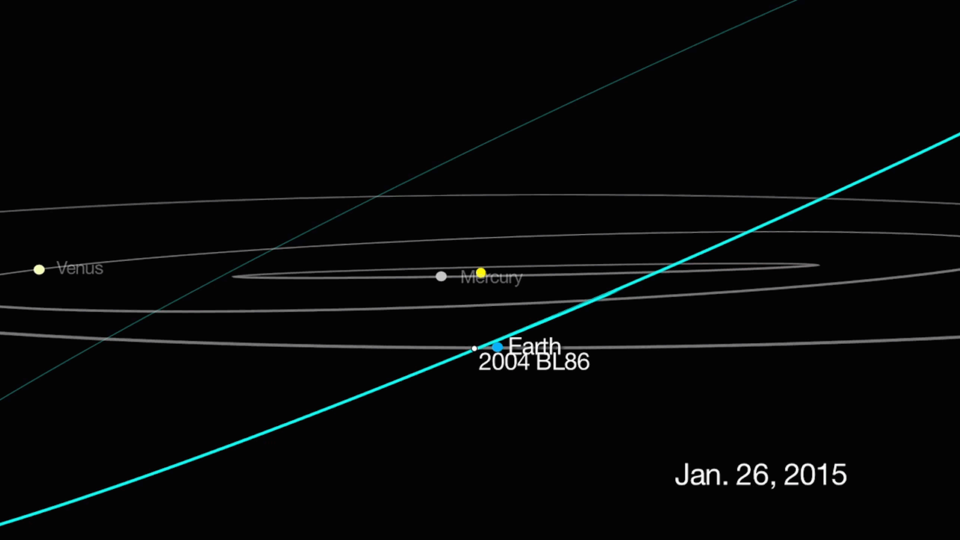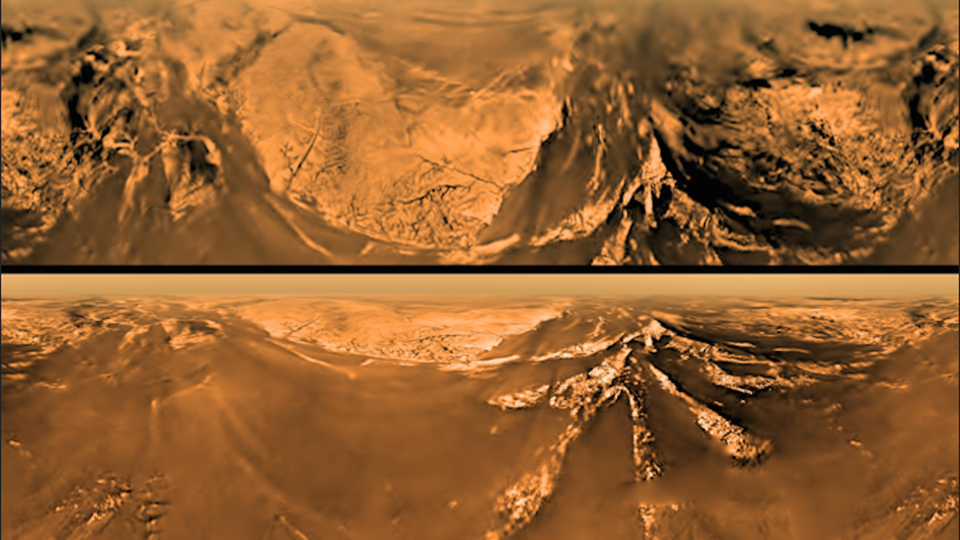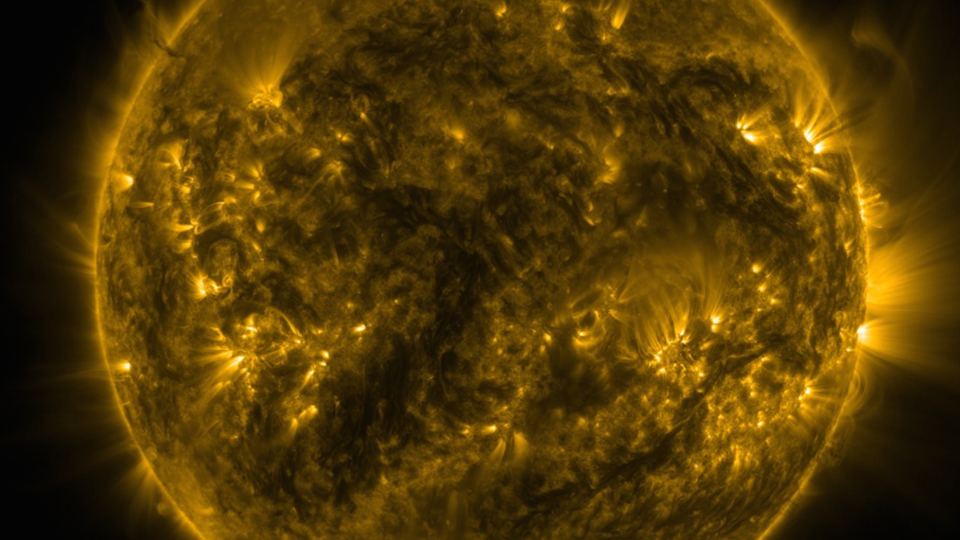Science News
Asteroids, Beagles, Solar Flares, and Titan, too
Watch an Asteroid Pass Near Earth
On the night of Monday, January 26, asteroid 2004 BL86 will pass Earth at about 745,000 miles (1.2 million km, or three times the Moon’s distance. While not by any means close enough to be of any concern, what makes this a special event is this asteroid’s size—nearly a half-mile across! This beefy asteroid is expected to reach a brightness of magnitude +9.0, which is too faint for the unaided eye, but should be visible through large binoculars or a moderately-sized amateur telescope. The asteroid will make its pass through the faint stars of Cancer the Crab, about 10 degrees west of Jupiter, moving at a relatively rapid clip of about two degrees (four Moon diameters) per hour. For stargazers with telescopes, it will pass near the open star cluster M-44 from 9-10 pm PST, as this detailed finder chart shows.
According to Don Yeomans, the retiring manager of NASA’s Near Earth Object Program, this will be the closest this asteroid will get to Earth for at least 200 years. Scientists operating NASA’s Deep Space Network antenna at Goldstone, California and the Arecibo Observatory in Puerto Rico will take advantage of this near-encounter by bouncing radar signals off the asteroid’s surface in an attempt to generate a map of its surface.
-Bing Quock
Ten Years of Titan
What a difference a decade makes! Ten years ago this week the NASA-ESA joint mission Cassini dropped a probe named Huygens into the clouds of Saturn’s moon Titan, and forever changed how we saw this intriguing world.
Fifteen years ago, we knew a few facts (trivia really) about the second largest moon in our solar system. In the years since, data collected from Huygens and Cassini have helped us understand this world as one full of similarities to our own, but with some tantalizing mysteries as well. We now know Titan has a thick and hazy atmosphere, as sampled by Huygens on its descent, Additionally, the surface is covered with dark dunes and huge hydrocarbon lakes that have few waves and chilly temperatures. We still speculate on the possibilities of a subsurface water ocean and wonder why Titan’s surf is so very calm. But the discoveries made by this team have opened our eyes to this mysterious moon and driven us to find out more in the decades to come.
-Josh Roberts
Beagle Missing for Eleven Years Found
No, not Snoopy and his earthbound kin, but rather the European Space Agency’s Beagle 2 spacecraft, which lost contact with Earth during its attempted landing on Mars on Christmas Day 2003. Designed to search for life on the Red Planet, the lander piggybacked to Mars on the Mars Express Orbiter, and was released six days before the scheduled landing at Isidis Planitia, an impact basin named after the Egyptian goddess Isis. When confirmation of a safe landing was not received from the spacecraft, it was assumed to have crashed—a major blow to mission managers at the National Space Centre in Leicester, UK, who had hoped that their first shot at landing on Mars might answer the question of whether life exists elsewhere. The spacecraft was declared lost in February 2004.
However, images just released by ESA and NASA, taken by the HIRISE camera aboard NASA’s Mars Reconnaissance Orbiter, show the lost Beagle intact on the surface, but with only two of its four petal-like solar panels properly unfolded. This means that it didn’t have enough power to communicate with either Mars Express or NASA’s Mars Odyssey spacecraft, which was also orbiting the Red Planet at the time—either one of which would’ve relayed the signal to Earth. Though the final explanation may never be known with certainty, some space experts are guessing that the impact of landing may have distorted the frame of the spacecraft just enough to prevent the two solar panels from deploying.
Presumed lost for 11 years, Beagle 2 is now known to have arrived safely on Mars, although it was unable to complete its mission. This discovery offers closure for ESA officials, who at least know that their first attempt to land on another planet actually succeeded.
-Bing Quock
Predicting Solar Flares
Solar flares are beautiful to observe, but can cut out satellite communications and damage power grids on Earth, even at 93 million miles away. In our increasingly technological world, the ability to predict these events becomes more important to prepare for outages and protect systems.
Solar physicists Monica Bobra and Sebastien Couvidat of Stanford wondered if machine learning could help predict these flares. Could the same methods used for search engines, internet advertising, and a host of other data-mining applications work on our massive star? After taking a popular course about it, they devised algorithms to look at data from NASA’s Solar Dynamic Observatory (SDO). And the amount of data collected by SDO’s Helioseismic Magnetic Imager (HMI) is huge: 1.5 terabytes of data a day!
The researchers catalogued flaring and non-flaring regions from a database of more than 2,000 active regions and then characterized those regions by 25 features such as energy, current, and field gradient. They then fed the learning machine 70 percent of the data, to train it to identify relevant features. Afterward, they used the machine to analyze the remaining 30 percent of the data to test its accuracy in predicting solar flares.
Machine learning confirmed that the topology of the magnetic field and the energy stored in the magnetic field are very relevant to predicting solar flares. Now it’s just a bit of finessing. The next step in solar flare prediction will be to incorporate data from the Sun’s atmosphere, Bobra says. And she’s up to the task. “It’s exciting because we not only have a ton of data, but the images are just so beautiful. And it’s truly universal. Creatures from a different galaxy could be learning these same principles.”
-Molly Michelson
Images: NASA


